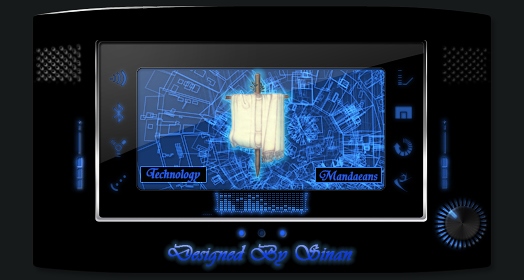Introduction
All Mandaeans, priests and
laymen during religious ceremonies must wear a ritual dress. The
garment is made of a natural fiber, usually cotton or muslin, although
silk is allowed. The color of this clothing is always white.
" If the vestments of a priest be silken there must be no snarls therein"
Modern
Mandaeans call this clothing " rasta". In the Mandaean religious
literature the rasta is referred to as ‘ustlia, an indication that at
one time the name was changed.
" 'ustlia d-Ziua "
"rainments (garments) of light"
The
ritual clothing is symbolic “of the heavenly dress of light, which
according to Mandaean religion, is worn by the ‘uthre (angels) and pure
souls”.
“Clothe yourself in white (garments) and cover yourself
in white (covering) like the garments of radiance and coverings of
light. Put on white turbans like resplendent wreaths.”
The rasta is put on before
a baptism and is used over and over again. The rasta is never washed
with soap and can become tinged brown due to the mud of the river.
There are several occasions
when a new rasta is called for: a wedding , the ordination of a priest
, at the feast of Dihba Daima, during the zidqa brika when a person is
acting as proxy , and for when a person is dying .
It is believed that one
time the Mandaeans dressed exclusively in the rasta. Modern Mandaeans
today wear a wide variety of clothing colors and styles, with western
dress being preferred.
While white is the color
preferred according to Mandaean scriptures, many Mandaeans today wear
clothes of different colors. Yet I know of Mandaeans who still insist
on wearing white or light colored clothes rather than dark or black
clothing. That old adage of “good guys wear the white hats” is
apparent.
"And when you say ‘On the day when they dressed Manda d Hiia in his vestments’ —the vestment he puts on shines out”
In the name of the Great Life!
On the day they clad Manda d-Hiia in his vestment
His radiance shone forth over the worlds of Light
His brilliance shone forth over the worlds of light
And the worlds of light that beheld his radiance
All gather to him, all flocked toward him
And opened their mouth an blessed Manda d-Hiia
Saying to him:
“Blessed
is thy radiance That shineth over the waters How bright is thy radiance
Thine appearance giveth out light and becometh not dim”
The ritual dress is made of
various parts. Lady Drower in her book The Mandaeans of Iraq and Iran
comments on two schools of thought in relationship to the number of
pieces contained in the rasta. According to the Mandaean priests of
Qal’at Salih there are 5 pieces pertaining to the layman’s attire and 7
pieces for the priest attire. Where as the priests of Amarah figure 7
pieces for the layman and 9 pieces for the priests. The difference is
that Amarah priests include the daša and takka as separate pieces while
the priests of Qal’at Salih consider these two pieces as part of the
ksuia and the šarwala.
The complete dress consists
of a tunic (sadra or ksuia), drawers (pants) (šarwala), girdle (belt)
(himiana), turban (burzinqa), and nasifa. The šarwala has a tie string
(tikta or takta or takka) and the ksuia a patch pocket (daša). In
addition to these a priest has his crown (taga) and his ring (šum
yawar).
After a priest has dressed
in the rasta, he double checks his clothing to make sure everything is
in order. He touches each part of the rasta in consecration making sure
every piece is where
it should be.
The priest recites:
"I consecrate (lit. set up) my leggings.
I consecrate the girdle with two virtues, with two knots
The dasha (pouch) on my right:
standing upright,
My rughza, my stole
My staff on my left (arm), my tagha on my right,
And my ring on my right (hand)
Righteousness make thee whole (he addresses the rasta) and establish me"
Sharwaley itres
Himiana itres bi trén tavi bi trén gatri
Dasha byaminey, qam qummey,
Rughzey nasifey
Marghna bsmaley, tagha byaminey
Uisakhtha ('saqta) byaminey
Kushta asiakh utrisey.
(prounciation is given for spelling)
Sandals are not considered
part of the rasta today, but there is clear indication in the Mandaean
scriptures that sandals (sandle) were used. As for sandals or shoes I
know personally of Mandaeans who never walk outside on the earth
without shoes or sandals upon their feet. This tradition could be a
throwback to those days
" Come, be for me a
loving shepherd and watch me a thousand out of ten thousand. I will
bring thee then sandals of glory with them canst thou trend down the
thorns and the thistles. Earth and heaven decay, but the sandals of
glory decay not. Sun and moon decay, but the sandals of glory decay
not. The stars and heaven's zodiacal circle decay, but the sandals of
glory decay not. The four winds of the [world-] house decay, but the
sandals of glory decay not. Fruits and grapes and trees decay, but the
sandals of glory decay not. All that is made and engendered decays,
but the sandals of glory decay not. So then be for me a loving
shepherd and watch me a thousand out of ten thousand."
"And the masitqa is supplied therewith, and the vestments- the tunic, stole, leggings, girdle, and sandals proceed from it..."
"...(and the men who) put their feet on the ground, for (there are?) pure shoes for their feet..."
Sandals of course are made
of a natural grass like material or wood, leather sandals are not
allowed. Dr. Buckley writes being allowed to enter the Mandi in Ahwaz
while wearing a pair of wooden sandals:
"...By special permission
from Sheik Jabber, I was granted a particular honor to enter on wooden
sandals into the windowless hut....."
